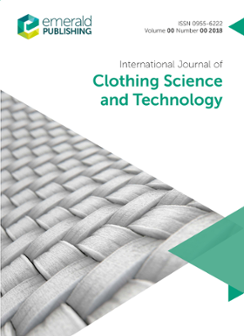Table of contents
CNN-based minor fabric defects detection
Zhijie Wen, Qikun Zhao, Lining TongThe purpose of this paper is to present a novel method for minor fabric defects detection.
The impact of sewing thread's tensile behavior and laundering process on the seam puckering of elastic and normal fabrics
Reyhaneh Kamali, Yasaman Mesbah, Fatemeh MousazadeganThe aim of the present study is to consider the influence of the tensile behavior of fabric and sewing thread on the seam appearance.
A novel equipment for making nanocomposites for investigating the antimicrobial properties of nanotextiles
Sergey Bereznenko, Natalia Bereznenko, Mykola Skyba, Dmytro Yakymchuk, Tetiana Artemenko, Dmytro Prybeha, Oleg Synyuk, Eugen KalinskyThe purpose of this article is the development of up-to-date equipment for making nanocomposites for investigation of the antimicrobial properties of nanotextiles and the creation…
Cut resistant characteristic of weft plain-knitted structure for protective clothing
Lijuan Wang, Chunhua Gu, Na Liu, Yindi He, Zhaofang DuThe paper aims to study cut resistant property of basic weft plain-knitted fabric for protective clothing.
Proposal for the development of sleeve patternmaking process and the definition of sleeve pattern structures for mass customization
Hyunsook Han, Hyunjung Han, Taehoon KimThe purpose of this study is to propose the parametric sleeve patternmaking method that enables mass customization.
Conversion from 3D to 2D pattern algorithm for the 3D-shaped knitwear
Xuan Luo, Gaoming Jiang, Honglian CongThe purpose of this paper is to develop the relationship among the three-dimensional-shaped (3D) knitwear on the flat knitting machine in a three-dimensional (3D) design model and…
The size prediction and auto-generation of garment template
Haisang Liu, Gaoming Jiang, Zhijia Dong, Fenglin Xia, Honglian CongThe size prediction of garment is an important part in the process of the garment design and production, and it is also one of the most important features in warp-knitted…
Identifying key quality features for wearable technology embedded products using the Kano model
Mir Salahuddin, Young-A LeeThe purpose of this study was to identify the major quality features of wearable technology embedded products that have the greatest impact on consumer satisfaction using the Kano…
A demand forecasting model based on the improved Bass model for fast fashion clothing
Xiaoxi Zhou, Jianfei Meng, Guosheng Wang, Qin XiaoxuanThis paper examines the problem of lack of historical data and inadequate consideration of factors influencing demand in the forecasting of demand for fast fashion clothing and…
Computer-aided design of weft-knitted two-side jacquard fabric
Jialu Liang, Honglian Cong, Zhe Gao, Aijun Zhang, Zhijia DongThe weft-knitted two-side jacquard fabric has the characteristics of complicated design principle and hard technical design. The purpose of this paper is to realize the…
Development of a dress design knowledge base (DDKB) based on sensory evaluation and fuzzy logic
Xue Ling, Yan Hong, Zhijuan PanThe purpose of this paper is to develop a dress design knowledge base (DDKB), which is expected to be further applied to a personalized dress recommendation system.

ISSN:
0955-6222Online date, start – end:
1989Copyright Holder:
Emerald Publishing LimitedOpen Access:
hybridEditor:
- Prof George Stylios